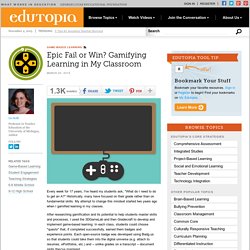

Gamifying Education: Do We Know How to Gamify the Classroom? Gamification in many parts of education is a sham.

Listening to the researchers and experts in this area has convinced me of that. If you’re interested in making your classroom more intriguing and powerful, read on. We can do better. Who Is Shaping The Gamifying Education Conversation? In this week’s conversation with Australian Gamer and researcher Lauren Ferro we all went on a bit of a rant about the ridiculous state of badges in education.Teacher Alice Keeler uses games all the time (and doesn’t give grades).Sixth grade teacher Michael Matera reinvented his whole sixth grade classroom as a Games Based classroom and shares how he did it.A Higher Ed Panel had a powerful conversation for why we need games in highered.
All of these are YouTube videos that have been recorded over the past week and a half as part of the Open Online Community (called an OOC) focusing on games in education. I have 3 take aways from the learning so far: #1: The Way We’re Doing Many Badges In Education Is A Joke. 4 Ways To Bring Gamification of Education To Your Classroom - Top Hat Blog. Epic Fail or Win? Gamifying Learning in My Classroom. Every week for 17 years, I've heard my students ask, "What do I need to do to get an A?

" Historically, many have focused on their grade rather than on fundamental skills. My attempt to change this mindset started two years ago when I gamified learning in my classes. After researching gamification and its potential to help students master skills and processes, I used the 3DGameLab and then Gradecraft to develop and implement game-based learning. In each class, students could choose "quests" that, if completed successfully, earned them badges and experience points. Each open-source badge was developed using Badg.us so that students could take them into the digital universe (e.g. attach to resumes, ePortfolios, etc.) and -- unlike grades on a transcript -- document skills they've mastered.
Steps to Gamify Learning 1. Using gamification software alleviates the time it takes to build quests, award points, and track progress. 2. Why The Future Of Education Involves Badges. Higher education institutions are abuzz with the concept of Open Badges.

Defined as a symbol or indicator of an accomplishment, skill, quality or interest, Open Badges are not only a hot topic as of late, but are also debated by some critics as the latest threat to higher education. A closer look at this emerging trend reveals benefits for traditional institutions and alternative learning programs alike. Some advocates have suggested that badges representing learning and skills acquired outside the classroom, or even in Massive Open Online Courses (MOOCs), will soon supplant diplomas and course credits. Recognizing Learning For higher education institutions interested in keeping pace, establishing a digital ecosystem around badges to recognize college learning, skill development and achievement is less a threat and more an opportunity. College-issued badges can respond to the challenges: Accredited higher education institutions already possess significant advantages. Badge Benefits. Beyond Badges: Why Gamify?
Mashable defines gamification as "applying game thinking or even game mechanics into a non-game context.

" Game mechanics in the "real world" include earning badges, completing missions and leveling up. Non-game companies, like Amazon, Deloitte and Salesforce.com, gamify to increase customer engagement. Gamification puts the customer on a journey motivated by intrinsic, or personally meaningful, rewards. An example is earning a "mayorship" badge on the mobile application Foursquare by "checking in" regularly to the same location. Gamification in the classroom has many benefits, too. After all, engaging a student intrinsically in the learning process, rather than with extrinsic motivators like grades, is the goal of every teacher. As a teacher, I assumed that game design had more to do with coding than the study of human behavior. Bartle's Player Types Gamification dates back to the 1996 publication of Bartle's Player Types Model. Social Engagement Verbs Flow, Fun and Serious Fun Examples.
4 Ways To Bring Gamification of Education To Your Classroom.